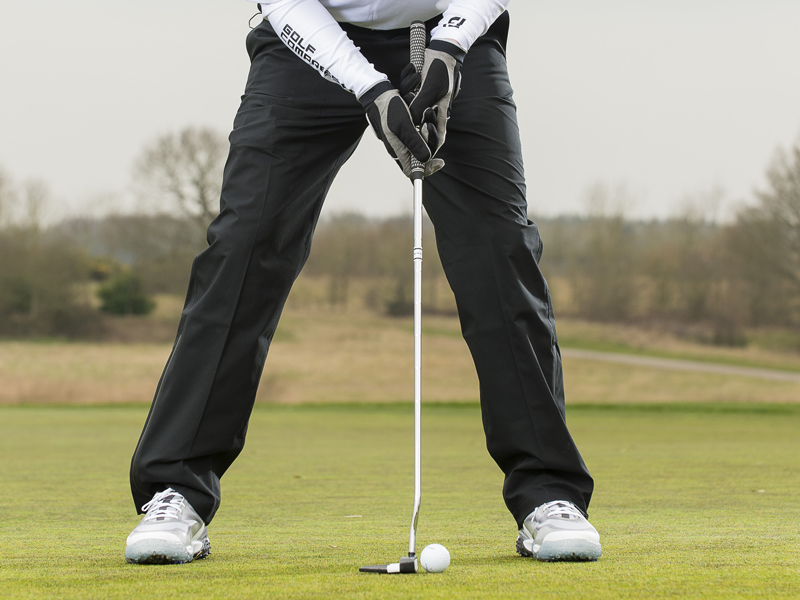Change your putting method this winter


In this exclusive video, Andrew Jones explains why you should change your putting method this winter to cope with wet, slow greens
In the winter the greens bear little resemblance to the perfectly manicured summer surfaces you are used to so it makes sense to change your putting method this winter. Widen your stance, bend your upper body over the ball more than usual and grip down the club. This will feel a little strange so you will need to practice it.
These adjustments are all geared to give you a lower your centre of gravity and make you far more stable. From here you should anchor your elbows into your rib cage, again this will make the stroke far more robust. The stroke itself needs to be to be shorter, more ‘punchy’ than usual to give you the momentum you need.
Watch more putting tips videos
If you want to change your putting method this winter, why not think about having a ‘winter putter’ as well. It should be slightly heavier to help on slower greens, proving more distance without you having to think about it.
Putting from close range is not very inviting even if you do change your putting method this winter. Imperfections on the green, scuff marks around the hole and cold hands can all conspire to make you feel like there is no chance of holing out. However, if you commit to your usual routine and concentrate on the stroke, you’ll be in the best place possible to make the putt.
Get the Golf Monthly Newsletter
Subscribe to the Golf Monthly newsletter to stay up to date with all the latest tour news, equipment news, reviews, head-to-heads and buyer’s guides from our team of experienced experts.
I don’t like to feel I’m ramming short putts in, in the winter. I prefer to have a slightly larger margin for error (the faster the ball rolls the more likely it is to lip out) so I like my pupils to roll the ball at a normal pace but allow for a little more break than usual.

In July 2023, Neil became just the 9th editor in Golf Monthly's 112-year history. Originally working with the best coaches in the UK to produce instruction content, he has also presented many Golf Monthly videos looking at all areas of the game from Tour player interviews to the rules of golf.
Throughout his time with the brand he has also covered equipment launches that date back well over a decade. He clearly remembers the launch of the Callaway and Nike square drivers as well as the white TaylorMade driver families, such as the RocketBallz! If you take a look at the Golf Monthly YouTube channel, you'll see his equipment videos dating back over a decade! He has also conducted 'What's In The Bag' interviews with many of the game's best players like Rory McIlroy, Dustin Johnson and Jon Rahm. Over the years, Neil has tested a vast array of products in each category and at drastically different price-points.
Neil is currently playing: Driver: TaylorMade Stealth Plus Fairway Wood: Titleist TSR2 Hybrid: Titleist TS3 Irons: PING Blueprint S (4&5), PING Blueprint T (6-PW) Wedges: Titleist Vokey SM7 50˚, 54˚, 60˚ Putter: Odyssey Triple Track Ten Ball: Titleist Pro V1X
-
 Zurich Classic Of New Orleans 2025 Picks, Odds And Predictions
Zurich Classic Of New Orleans 2025 Picks, Odds And PredictionsThe pairs tournament returns to TPC Louisiana, with Rory McIlroy and Shane Lowry hoping to defend their title
By Matt Cradock
-
 LIV Golf Mexico City 2025 Picks, Odds And Predictions
LIV Golf Mexico City 2025 Picks, Odds And PredictionsCheck out the odds for the leading players at LIV Golf Mexico City as well as our favorite and outside picks for this week's tournament in Naucalpan
By Jonny Leighfield
-
 How To Create Lag In The Golf Swing
How To Create Lag In The Golf SwingAndrew Jones explains how to create lag by adding speed to your swing without killing accuracy
By Golf Monthly
-
 Short Putting Drills
Short Putting DrillsBy Neil Tappin
-
 Golf Ball Striking Drills
Golf Ball Striking DrillsBy Neil Tappin
-
 How to play fairway trap shots
How to play fairway trap shotsBy Neil Tappin
-
 Ball above feet golf tips
Ball above feet golf tipsBy Neil Tappin
-
 Short putting fault fixer video
Short putting fault fixer videoClive Tucker provides some short putting fault fixer tips, as he addresses the most common mistakes from close range on the greens.
By Thomas Patrick Clarke